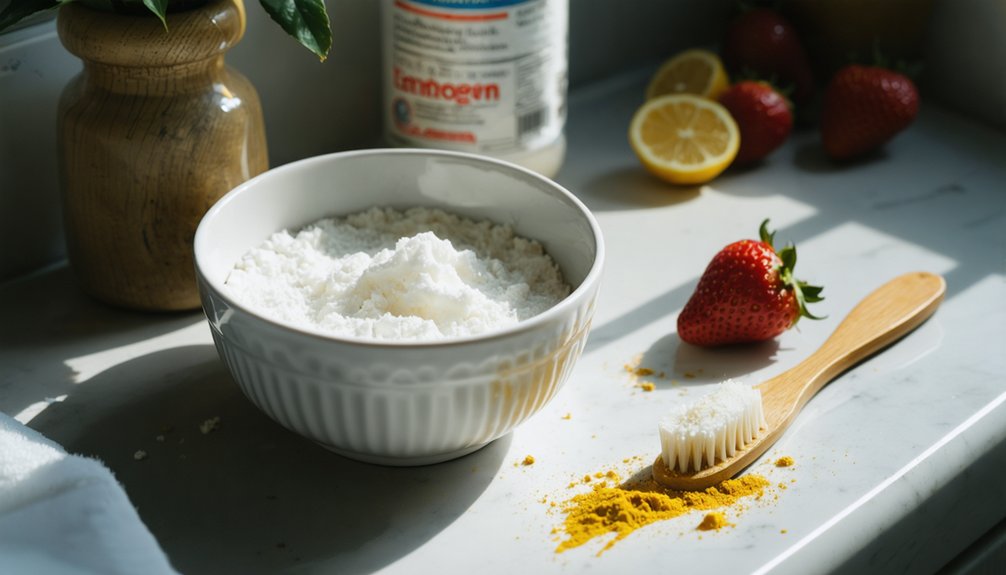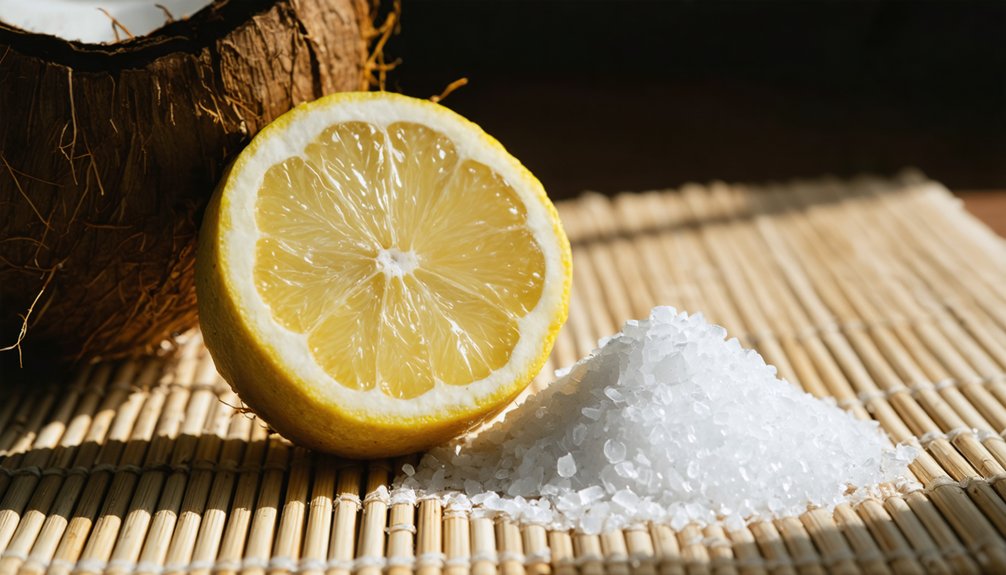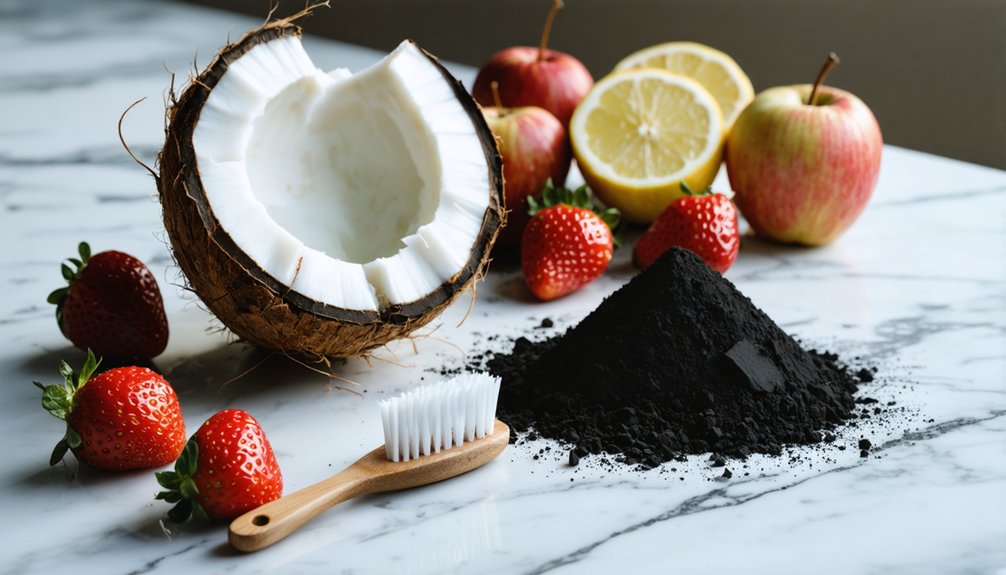Natural teeth whitening methods work effectively through several mechanisms to brighten your smile. You’ll find enzymatic compounds like bromelain and papain that break down stains, while organic acids from fruits help prevent new discoloration. Crunchy fruits and vegetables provide mechanical cleaning action, and ingredients like activated charcoal and baking soda offer gentle surface stain removal. When combined with proper dental hygiene, these natural approaches can produce gradual results while protecting your enamel’s integrity.
Key Takeaways
- Natural whitening substances contain enzymes like ficin, bromelain, and papain that effectively break down tooth stains.
- Organic acids found in natural ingredients prevent stain formation and provide gentle whitening without damaging tooth enamel.
- Crunchy fruits and vegetables act as natural mechanical cleaners, physically removing surface stains while promoting oral health.
- Natural methods are generally gentler than chemical treatments, reducing tooth sensitivity while maintaining better cell viability.
- Nutrient-rich foods like strawberries and pineapples contain natural compounds that help remove stains and strengthen teeth simultaneously.
The Science Behind Natural Whitening Agents
While traditional teeth whitening methods often rely on peroxide-based agents, natural whitening substances work through distinct biological and chemical mechanisms to achieve their brightening effects.
You’ll find that natural whiteners utilize enzymatic action through compounds like ficin, bromelain, and papain, which break down the proteins responsible for tooth discoloration.
These natural alternatives also incorporate organic acids found in fruits and vegetables, which help prevent stain formation while gently whitening your teeth. The pH level balance is crucial for maintaining healthy enamel during the whitening process.
Though they’re less potent than peroxide treatments, natural whitening agents offer significant advantages: they’re gentler on your enamel, reduce tooth sensitivity, and maintain better cell viability.
Activated charcoal has emerged as a popular natural whitening option for those seeking gentle stain removal.
While results may take longer to achieve, you can expect noticeable improvements with consistent use, making these methods particularly suitable for patients seeking safer, long-term whitening solutions.
Common Natural Ingredients for Brighter Teeth
Natural whitening agents work through specific compounds found in everyday ingredients you likely have in your kitchen or local store.
When considering activated charcoal benefits, you’ll find its abrasive particles effectively remove surface stains, though you should use it cautiously to protect your enamel.
Baking soda use offers a gentler approach, providing mild abrasiveness that’s generally safe for occasional application.
For a food-based approach, strawberries contain malic acid that helps break down stains, while crunchy fruits and vegetables naturally scrub teeth through mechanical action.
A balanced nutrient intake supports your teeth’s natural white appearance while maintaining optimal dental health.
Though oil pulling with coconut or sesame oil is popular, scientific evidence supporting its whitening claims remains limited.
Each method works differently, from mechanical stain removal to chemical breakdown, giving you various options for natural teeth brightening.
Regular consultation with dental professionals is essential as certain dental conditions may make natural whitening methods unsuitable for some individuals.
How Diet Affects Tooth Color and Health
Your daily food and beverage choices play an essential role in maintaining bright, healthy teeth, as common items like coffee, tea, and red wine can greatly stain tooth enamel over time.
You’ll protect your teeth’s natural whiteness by limiting acidic and sugary foods that weaken enamel, while incorporating tooth-strengthening foods rich in calcium and phosphorus.
Proper nutrition across all five major food groups helps prevent oral health issues and staining. Making mindful dietary choices, such as drinking water after consuming staining beverages and eating crunchy fruits and vegetables that naturally clean teeth, can help preserve your smile’s brightness. Regular dental cleanings performed by professionals remove stubborn stains and plaque buildup that diet alone cannot address.
Staining Foods to Avoid
Since daily food and beverage choices greatly influence tooth color, understanding which items cause staining can help protect your smile’s brightness.
You’ll want to minimize consumption of staining fruits like blueberries, blackberries, and pomegranates, which contain powerful chromogens that discolor teeth. Dark artificial candies can have similar staining effects. Acidic beverages, including citrus juices and sports drinks, pose a double threat by eroding enamel and making teeth more susceptible to stains.
Be particularly cautious with tannin-rich beverages like coffee, tea, and red wine, as these compounds cling tenaciously to tooth surfaces. Using a straw for cold drinks can help minimize direct contact between staining beverages and your teeth.
Tomato-based sauces and vibrant spices such as curry and turmeric can also contribute to discoloration. When you do consume these items, rinse your mouth with water afterward and maintain consistent brushing habits to minimize their staining effects.
Beneficial Foods for Whiteness
While some foods can stain teeth, others actively promote whiteness through their natural compounds and physical properties.
You’ll find that nutrient-rich fruits and crunchy vegetables work in multiple ways to enhance your smile’s brightness naturally.
- Fruits like strawberries and pineapples contain natural acids and enzymes (malic acid and bromelain) that break down surface stains while protecting enamel integrity. For best results, wait 30 minutes before brushing teeth after consuming these fruits. Watermelon offers similar benefits with its higher malic acid content.
- Crunchy vegetables such as celery, carrots, and broccoli act as natural tooth scrubbers, mechanically removing plaque and stimulating beneficial saliva production.
- Dairy products, particularly aged cheeses, strengthen enamel through their calcium content while the casein protein helps prevent new stains from forming.
These foods work together to maintain your teeth’s natural whiteness while supporting overall oral health through their unique chemical and physical properties.
Daily Eating Habits Matter
The foods and beverages you consume daily play a critical role in maintaining your teeth’s natural color and structural integrity. When you frequently expose your teeth to acidic foods and chromogen-rich beverages like coffee, tea, and red wine, you’re increasing their vulnerability to staining and erosion.
Your meal timing greatly impacts tooth health – consuming acidic foods with meals rather than between them helps minimize enamel damage. Your beverage choices throughout the day can either protect or compromise your teeth’s appearance.
While milk offers protective calcium benefits, dark sodas and citrus drinks contribute to enamel erosion, revealing yellower dentin beneath. To preserve your teeth’s natural whiteness, it’s vital to manage both the frequency and timing of exposure to staining agents while maintaining proper oral hygiene.
Safety and Limitations of Natural Whitening

Natural teeth whitening methods, though appealing for their accessibility and perceived safety, carry considerable risks that warrant careful consideration.
Regular use of abrasive or acidic agents can lead to irreversible enamel erosion, while improper application often results in gum irritation and chemical burns.
Consider these critical limitations:
- Once lost, tooth enamel doesn’t regenerate, leaving your teeth permanently vulnerable to sensitivity and decay.
- Natural whitening agents primarily address surface stains, showing minimal effectiveness on deeper discoloration.
- Results can take weeks or months to appear, with outcomes varying markedly between individuals.
You’ll achieve more predictable and safer results through professional supervision, as natural methods lack substantial clinical evidence supporting their long-term safety and efficacy.
Comparing Natural Methods to Professional Options
Given the safety concerns surrounding natural whitening methods, understanding how they stack up against professional treatments becomes particularly relevant.
When comparing natural vs. professional approaches, you’ll find considerable differences in both effectiveness and speed of results. Professional treatments utilize high-concentration hydrogen peroxide (25-40%), achieving up to 8 shade improvements in a single session.
Natural methods, relying on mild abrasives or diluted agents, produce minimal whitening effects over extended periods.
Professional whitening effectiveness stems from dentist supervision, customized treatment plans, and clinical-grade materials. You’ll receive personalized care that considers your tooth sensitivity and existing dental work.
While natural methods are budget-friendly, costing considerably less than professional treatments ($300+), they lack the deep-penetrating action and lasting results of professional whitening services.
Strategies for Maximizing Natural Whitening Results

While pursuing natural teeth whitening methods, implementing an inclusive strategy that combines mechanical stain removal, dietary modifications, and enhanced oral hygiene practices will maximize your results.
Focus on natural brushing with crunchy fruits and vegetables to help remove surface stains while stimulating beneficial saliva production.
Crunchy fruits and vegetables act as natural toothbrushes, gently scrubbing away stains while promoting healthy saliva flow for cleaner teeth.
To optimize your natural whitening efforts:
- Incorporate apples, celery, and carrots into your daily diet for mechanical cleaning between regular brushing sessions.
- Minimize exposure to staining agents by using a straw for beverages and rinsing your mouth immediately after consuming pigmented foods.
- Support saliva stimulation through sugar-free gum chewing, which helps neutralize acids and naturally cleanse your teeth throughout the day.
Remember to maintain consistent oral hygiene habits while avoiding acidic whitening agents that could damage your enamel.
Frequently Asked Questions
Can Natural Whitening Methods Reverse Deep-Set Stains From Years of Smoking?
You won’t be able to remove deep-set stains from smoking effects using natural methods alone. Professional treatments are necessary to effectively penetrate and eliminate these long-term tobacco discolorations.
How Long Should I Wait Between Different Natural Whitening Treatments?
Like waves gently lapping at a shore, your timing strategies should space treatments 2-3 days apart. Maintain this treatment frequency while monitoring for sensitivity to protect your enamel’s integrity.
Will Natural Whitening Work on Dental Crowns or Veneers?
Natural whitening won’t effectively change your crowns or veneers. These restorations’ durability comes from artificial materials that resist staining and whitening. Professional maintenance is your best option for restoring their appearance.
Can Children Safely Use Natural Teeth Whitening Methods?
You can safely use natural whitening methods like crunchy fruits and vegetables for children, but consult a dentist first. Wait until age 12-14 for any chemical treatments due to safety concerns.
Does Activated Charcoal Really Work Better Than Other Natural Whitening Methods?
You won’t find better results with activated charcoal compared to other natural alternatives. Research shows its whitening efficacy is limited and potentially more damaging to your teeth’s enamel than conventional methods.
References
- https://pmc.ncbi.nlm.nih.gov/articles/PMC10024105/
- https://pmc.ncbi.nlm.nih.gov/articles/PMC4058574/
- https://www.ada.org/resources/ada-library/oral-health-topics/whitening
- https://healthcare.utah.edu/the-scope/health-library/all/2023/10/does-home-teeth-whitening-really-work
- https://www.urmc.rochester.edu/news/publications/health-matters/diy-teeth-whitening-too-good-to-be-true
- https://www.frontiersin.org/journals/dental-medicine/articles/10.3389/fdmed.2021.687507/full
- https://www.luriedental.com/dental-services/cosmetic/blog/do-natural-teeth-whitening-remedies-really-work
- https://cosmeticdentistryofsa.com/the-science-behind-teeth-whitening/
- https://sandlakedental.com/blog/understanding-the-science-behind-teeth-whitening/
- https://www.nature.com/articles/s41598-020-66733-z



